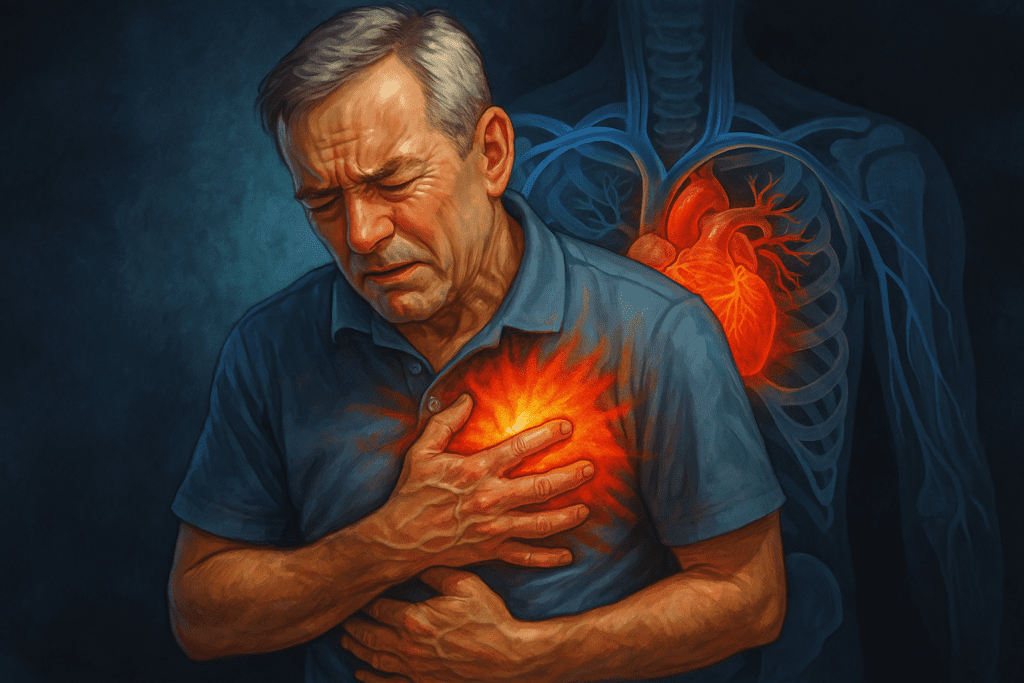Understanding the Hidden Threat of a Silent Heart Attack
A silent heart attack is a cardiovascular event that occurs without the dramatic chest-clutching symptoms most people associate with heart attacks. Unlike traditional heart attacks, which often involve crushing chest pain, cold sweats, and shortness of breath, a silent heart attack can unfold with barely noticeable or entirely absent warning signs. Yet despite this subtlety, the damage to the heart is very real—and potentially deadly. Understanding what a silent heart attack is, how it develops, and why it often goes unnoticed is the first step toward protecting yourself or someone you love from its long-term consequences.
You may also like: 5 Ways to Keep Your Heart Healthy and Prevent Cardiovascular Disease
While the term “silent” might imply harmlessness, these heart attacks are anything but. They account for a significant proportion of all myocardial infarctions (MIs) and can leave scar tissue on the heart muscle that compromises cardiac function. In fact, studies suggest that nearly 1 in 5 heart attacks is silent, often discovered later through electrocardiograms or imaging. The implications are profound, especially when considering that life expectancy after a silent heart attack may be reduced if the condition is not properly diagnosed and managed.
Why Silent Heart Attacks Are Often Missed
One of the most concerning aspects of silent heart attacks is how easily they can be misinterpreted or ignored. People may attribute the symptoms to indigestion, fatigue, or a lingering flu. This is particularly common among older adults, individuals with diabetes, and women—groups in which heart attack symptoms often present differently than in the classic textbook scenario. For example, instead of sharp chest pain, a person may simply feel tired, mildly short of breath, or experience a vague discomfort in the neck, jaw, or back.
Diabetes, in particular, can mask the symptoms of heart attacks due to diabetic neuropathy, which reduces the ability to feel pain. For this reason, silent MI symptoms frequently go unrecognized until much later, when the cumulative effects on the heart become apparent. And because the immediate danger feels less urgent, individuals may not seek medical care in time to limit the damage. This delay in detection and treatment makes it even more critical to raise awareness about these less obvious signs.

Recognizing Silent Heart Attack Symptoms
Recognizing silent heart attack symptoms requires a shift in mindset. Instead of waiting for dramatic signs, individuals need to be attuned to subtler changes in their bodies. Common silent MI symptoms include unexplained fatigue, lightheadedness, mild discomfort in the chest, arms, or upper back, nausea, or even excessive sweating without exertion. In some cases, there may be no symptoms at all—a reality that underscores the importance of regular health screenings, particularly for those with risk factors such as hypertension, high cholesterol, obesity, smoking, or a family history of heart disease.
In women, symptoms can be even more nuanced. A silent heart attack might present as difficulty sleeping, anxiety, or indigestion-like discomfort. These vague symptoms are easily brushed off or attributed to less serious causes. Unfortunately, this often leads to a delay in diagnosis and treatment, increasing the risk of long-term heart damage. It’s crucial to recognize that just because a heart attack is silent doesn’t mean it is harmless.
Understanding the Long-Term Impact on Life Expectancy
One of the most pressing concerns after a silent heart attack is how it affects long-term health outcomes, especially life expectancy. Research shows that individuals who have experienced a silent heart attack are at significantly higher risk for future cardiac events, including full-blown heart attacks and sudden cardiac arrest. Moreover, because the initial event often goes untreated, the heart may suffer from unnoticed damage that compromises its ability to function efficiently over time.
Life expectancy after a silent heart attack depends on several factors, including the extent of the damage, the patient’s age, comorbid conditions, and the effectiveness of subsequent treatment and lifestyle changes. While early detection and comprehensive cardiac care can mitigate much of the risk, the prognosis is typically less favorable than for those who receive prompt treatment for symptomatic heart attacks. This reality underscores the importance of proactive cardiovascular care, especially among high-risk populations.
Can You Have a Heart Attack and Be OK After?
The question “Can you have a heart attack and be OK after?” is particularly relevant in the context of silent heart attacks. The answer is complex. Yes, many people do survive heart attacks—silent or otherwise—and go on to live full, healthy lives. However, this often depends on how quickly the event is detected and managed. When a silent heart attack goes unnoticed, the person may not receive the medications, lifestyle guidance, or monitoring needed to prevent further damage.
Survivors of silent heart attacks may appear outwardly healthy but face an elevated risk for future events. Without intervention, these individuals are more likely to experience another, potentially more severe, heart attack. This makes follow-up care, including cardiac rehabilitation and ongoing lifestyle modifications, critical to long-term recovery. The concept of being “OK” after a heart attack, therefore, hinges on access to comprehensive care and a commitment to cardiovascular health.
Mini Heart Attack Without the Pain: A Medical Reality
The idea of a mini heart attack without the pain may sound paradoxical, but it is a medically recognized phenomenon. Also known as a non-ST elevation myocardial infarction (NSTEMI), a mini heart attack is less severe in terms of immediate symptoms but still results in measurable damage to the heart. Like silent heart attacks, mini heart attacks often go unrecognized, especially when they occur without the hallmark symptom of chest pain.
These events are particularly dangerous because they can lull patients into a false sense of security. A person might feel a bit off—slightly nauseated or fatigued—but not ill enough to seek emergency care. Yet, the damage accumulates silently, putting the patient at greater risk for future, more severe cardiovascular events. Understanding that a heart attack doesn’t have to be dramatic to be serious is key to preventing long-term health complications.
How to Spot a Silent Heart Attack Before It’s Too Late
Because silent heart attacks don’t announce themselves with blaring alarms, spotting one in time requires vigilance, awareness, and often a willingness to act on vague or seemingly minor symptoms. If you experience persistent fatigue, dizziness, unexplained sweating, or even a general sense of malaise, especially if you have risk factors for cardiovascular disease, it’s essential to consult a healthcare provider. Blood tests, electrocardiograms (ECGs), and cardiac imaging can reveal the telltale signs of damage.
Routine physical exams are an essential defense against undiagnosed cardiovascular events. For individuals with diabetes, regular cardiovascular screening is especially important. Similarly, people with a family history of heart disease or those over the age of 50 should not ignore subtle changes in their physical condition. Taking these signs seriously can lead to early diagnosis and better long-term outcomes.

The Role of Preventive Care and Lifestyle Choices
Preventive care is the cornerstone of protecting your life expectancy after a silent heart attack. This involves not only regular checkups and screenings but also adopting a lifestyle that supports heart health. Key strategies include maintaining a healthy diet rich in vegetables, whole grains, lean proteins, and healthy fats; engaging in regular physical activity; managing stress; and avoiding tobacco products. These habits may seem simple, but their impact on cardiovascular health is profound.
Medication adherence is another crucial component. After a silent heart attack, physicians may prescribe medications such as beta-blockers, statins, ACE inhibitors, or antiplatelet drugs to reduce the risk of future events. Skipping or inconsistently taking these medications can compromise their effectiveness, increasing the likelihood of complications. Combining lifestyle changes with appropriate pharmacological therapy offers the best chance of preserving heart function and extending life expectancy.
Understanding Risk Factors for Silent Heart Attacks
To reduce the likelihood of experiencing a silent heart attack, it’s important to understand the risk factors. These include many of the same contributors to traditional heart disease, such as hypertension, hyperlipidemia, obesity, diabetes, smoking, and a sedentary lifestyle. Additionally, stress, sleep disorders like sleep apnea, and poor diet can all increase cardiovascular risk. Recognizing these factors is the first step toward addressing them proactively.
Interestingly, research indicates that silent heart attacks are more common in certain demographics, including older adults, African Americans, and women. These groups may experience different symptom patterns or reduced symptom awareness, contributing to delayed diagnoses. Healthcare providers are increasingly focusing on culturally competent care and community education to address these disparities and improve cardiovascular outcomes across diverse populations.
Navigating Recovery After a Silent Heart Attack
Recovery after a silent heart attack involves more than just physical healing. It requires a comprehensive approach that addresses physical health, emotional well-being, and long-term prevention. Cardiac rehabilitation programs can be especially valuable, offering structured support for exercise, dietary changes, and stress management. These programs also provide education about recognizing future symptoms and understanding how to monitor one’s heart health.
Emotional recovery is often overlooked but just as important. Many patients struggle with anxiety, depression, or fear of recurrence after a cardiac event. Mental health support, whether through counseling, peer support groups, or mindfulness practices, can make a significant difference in quality of life. By addressing both the physical and emotional dimensions of recovery, individuals are more likely to adhere to treatment plans and adopt lasting lifestyle changes.
When to Seek Medical Advice Immediately
While silent heart attacks are defined by their lack of dramatic symptoms, that does not mean any potential warning signs should be ignored. If you notice unusual fatigue, unexplained shortness of breath, mild chest or jaw discomfort, or any symptom that feels different from your norm—particularly if you have known cardiovascular risk factors—seek medical advice. It is always better to err on the side of caution than to miss the window for intervention.
Emergency departments have the tools needed to quickly evaluate your heart health. Blood markers such as troponin levels, along with ECGs and imaging tests, can help confirm whether a silent MI has occurred. Time is muscle when it comes to heart attacks—even the silent ones. Prompt evaluation and treatment can dramatically reduce the risk of long-term damage and improve survival.
Why Early Detection Changes the Outcome
Early detection of a silent heart attack can dramatically shift the trajectory of a patient’s health. When caught early, the damage can be minimized through medications, lifestyle changes, and sometimes surgical interventions like angioplasty or bypass surgery. Early intervention allows the heart to heal more effectively and reduces the risk of heart failure, arrhythmias, and other complications.
Moreover, early detection provides a critical opportunity for education and behavior change. Patients become more aware of their cardiovascular health, more likely to monitor symptoms, and better equipped to prevent recurrence. In this way, recognizing silent MI symptoms is not just about preventing death—it’s about improving quality of life and long-term heart function.

Frequently Asked Questions (FAQ): Silent Heart Attacks and Their Hidden Dangers
What makes silent heart attack symptoms so easy to miss?
Silent heart attack symptoms are notoriously easy to overlook because they often present as nonspecific, mild discomforts. Instead of classic chest pain, someone might feel a vague pressure in the upper back or jaw, experience lightheadedness, or simply feel unusually fatigued. These sensations are frequently mistaken for stress, indigestion, or even aging. Individuals often dismiss them or fail to connect them with a cardiac event. Adding to the challenge, silent MI symptoms may appear gradually or resolve quickly, misleading patients into thinking nothing serious happened—yet these “quiet” episodes still leave lasting damage.
How does a silent heart attack affect life expectancy even if there are no immediate symptoms?
Despite their stealthy presentation, silent heart attacks can drastically impact long-term survival. When the heart muscle sustains damage without intervention, scar tissue forms, reducing cardiac efficiency over time. This hidden injury increases the risk of developing heart failure, arrhythmias, or another, more severe heart attack down the line. Life expectancy after a silent heart attack is often shortened, especially if no follow-up care is provided. That said, early detection through imaging or routine ECGs offers a vital opportunity to reverse course with medication and lifestyle changes.
Is it true you can have a heart attack and be OK after?
Yes, it is possible to have a heart attack and recover, but outcomes vary widely depending on several factors. The phrase “can you have a heart attack and be ok after” often depends on the severity of the event, speed of medical response, and underlying heart health. Many people survive both silent and symptomatic heart attacks, especially with prompt diagnosis and adherence to treatment. However, being “OK” often means living with a heightened risk of future events. True recovery includes making informed lifestyle changes and consistently managing blood pressure, cholesterol, and other risk factors to avoid additional heart damage.
Can silent heart attacks occur during sleep?
Yes, and this makes them particularly insidious. A silent heart attack may happen while a person is sleeping, especially if they have preexisting cardiovascular conditions or sleep apnea, which increases cardiac stress. People might wake up feeling unusually tired, short of breath, or with a strange sense of unease but may not associate these symptoms with heart trouble. Because no dramatic event was observed, the connection is rarely made. Silent MI symptoms that emerge upon waking—like persistent fatigue or subtle chest tightness—should never be ignored.
How is a mini heart attack without the pain diagnosed if the person never feels seriously ill?
Doctors often identify a mini heart attack without the pain through routine tests like an ECG or cardiac enzyme blood work, especially if a patient reports subtle symptoms like fatigue or shortness of breath. These “mini” attacks can show up as small changes in heart rhythm or scarring on imaging tests like an echocardiogram or cardiac MRI. Many patients are shocked to learn they’ve already had a heart event. What feels like a brief episode of indigestion or exertion-related discomfort can, in retrospect, match silent heart attack symptoms. Ongoing screening is essential for at-risk individuals, even in the absence of dramatic symptoms.
Can anxiety mask or mimic silent MI symptoms?
Absolutely. The overlap between anxiety and silent MI symptoms often leads to misdiagnosis or delayed treatment. Symptoms like chest tightness, dizziness, and palpitations are common in both conditions. However, anxiety typically resolves with rest or calming techniques, whereas a silent heart attack often results in prolonged, unexplained fatigue or discomfort. When patients attribute their symptoms solely to stress or panic, they may miss the opportunity for early intervention. Consulting a cardiologist for persistent or recurrent symptoms—even when anxiety is present—can be life-saving.
What is the psychological impact of discovering a past silent heart attack?
Learning you’ve had a silent heart attack without knowing it can be emotionally jarring. Patients frequently report feelings of vulnerability, anxiety about their mortality, and a deep mistrust in their body’s signals. The discovery often changes their entire approach to health, prompting reevaluation of diet, exercise, and medical adherence. While some experience post-traumatic stress symptoms, others become more empowered and proactive in managing their heart health. Addressing the psychological aftermath with support groups or therapy is often just as important as medical follow-up, especially for those facing a reduced life expectancy after a silent heart attack.
How can families help a loved one who may have experienced silent MI symptoms?
Family members can play a pivotal role in recognizing subtle signs of cardiac distress and encouraging medical evaluation. If a loved one frequently complains of unusual fatigue, mild chest tightness, or seems to be “slowing down” without explanation, these could be silent MI symptoms. Offering to accompany them to a doctor’s appointment can make a big difference. Educating the whole family about silent heart attack warning signs fosters a culture of awareness and prevention. Involving loved ones in dietary changes, stress reduction techniques, or walking routines can improve outcomes for the entire household.
What are some emerging technologies that might help detect a silent heart attack earlier?
Wearable technology is advancing rapidly in this area. Devices that track heart rate variability, oxygen saturation, and even detect arrhythmias can provide early warnings that align with silent heart attack symptoms. Smartwatches with ECG capabilities now alert users to irregular rhythms that may indicate a prior, undetected cardiac event. In the future, integration of artificial intelligence into these tools may help flag silent MI symptoms with greater accuracy. These innovations could improve life expectancy after a silent heart attack by allowing earlier medical intervention, especially among high-risk populations.
How does the concept of a mini heart attack without the pain change clinical practice?
The recognition of a mini heart attack without the pain has led to a shift in clinical protocols, especially in emergency and primary care settings. Providers are now more likely to take patient-reported symptoms seriously, even when they don’t align with the classic heart attack profile. New guidelines emphasize screening for silent heart attack symptoms in diabetic, elderly, and female patients. This shift has led to earlier detection, better secondary prevention strategies, and more nuanced treatment plans. Ultimately, acknowledging these “quiet” events changes the way clinicians assess cardiac risk and improve the odds of surviving and thriving post-MI.
Protecting Your Heart and Future: A Call to Awareness
Understanding the risks and realities of silent heart attacks is not merely a matter of academic interest—it can be life-saving. By learning to recognize the often subtle symptoms and acting quickly, individuals can significantly improve their outcomes and safeguard their future. Although silent heart attacks do not always present the way we expect, they are no less dangerous and require just as much attention and care.
Proactively managing your cardiovascular health through regular screenings, lifestyle changes, and informed vigilance can dramatically alter your life expectancy after a silent heart attack. The good news is that, with proper care and awareness, many people go on to live long, healthy lives. But this outcome hinges on education, recognition, and timely intervention. Don’t wait for a loud warning. Sometimes the most dangerous threats are the quietest ones of all.
heart disease warning signs, asymptomatic heart attack, myocardial infarction risk factors, cardiovascular event detection, undiagnosed heart damage, heart attack prevention strategies, heart muscle scarring, cardiac health monitoring, post-heart attack recovery, early signs of heart disease, heart attack in women, diabetic heart complications, aging and heart health, stress and heart conditions, ECG heart damage detection, cardiac risk screening, unexpected cardiac symptoms, sleep and heart function, wearable heart monitors, long-term heart health care
Further Reading:
What is a silent heart attack?
Silent heart attack: Warning signs you shouldn’t ignore
Disclaimer
The information contained in this article is provided for general informational purposes only and is not intended to serve as medical, legal, or professional advice. While MedNewsPedia strives to present accurate, up-to-date, and reliable content, no warranty or guarantee, expressed or implied, is made regarding the completeness, accuracy, or adequacy of the information provided. Readers are strongly advised to seek the guidance of a qualified healthcare provider or other relevant professionals before acting on any information contained in this article. MedNewsPedia, its authors, editors, and contributors expressly disclaim any liability for any damages, losses, or consequences arising directly or indirectly from the use, interpretation, or reliance on any information presented herein. The views and opinions expressed in this article are those of the author(s) and do not necessarily reflect the official policies or positions of MedNewsPedia.


